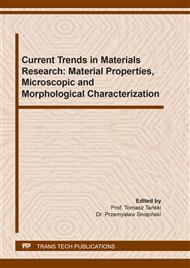p.75
p.89
p.101
p.111
p.125
p.149
p.157
p.167
p.185
Chemical Composition of Alloys as Primary Material Property Influencing the Accuracy of Measurements Obtained in Energy-Dispersive X-Ray Spectroscopy (EDS), Wavelength-Dispersive X-Ray Spectroscopy (WDX) and X-Ray Fluorescence (XRF)
Abstract:
The properties of the material affect the quality of the manufactured product. Before transferring the finished product to the production phase and sending it to the customer, material tests should be carried out. Examined material properties such as chemical composition, phase composition, grain boundaries influence results obtained after measurements of the chemical composition. The spectrometers used in SEM or as separate XRFs can be compared due to the principle of operation. The main difference in EDS/WDX or XRF is the types of a beam that excite the characteristic X-rays radiation peaks. Unfortunately, both types of spectroscopy have limitations due to materials properties such as the application light chemical elements in alloys an example of B. As well as small quantities of chemical elements in used alloys that affect the obtained results.
Info:
Periodical:
Pages:
185-190
Citation:
Online since:
November 2021
Authors:
Price:
Сopyright:
© 2021 Trans Tech Publications Ltd. All Rights Reserved
Share:
Citation:


